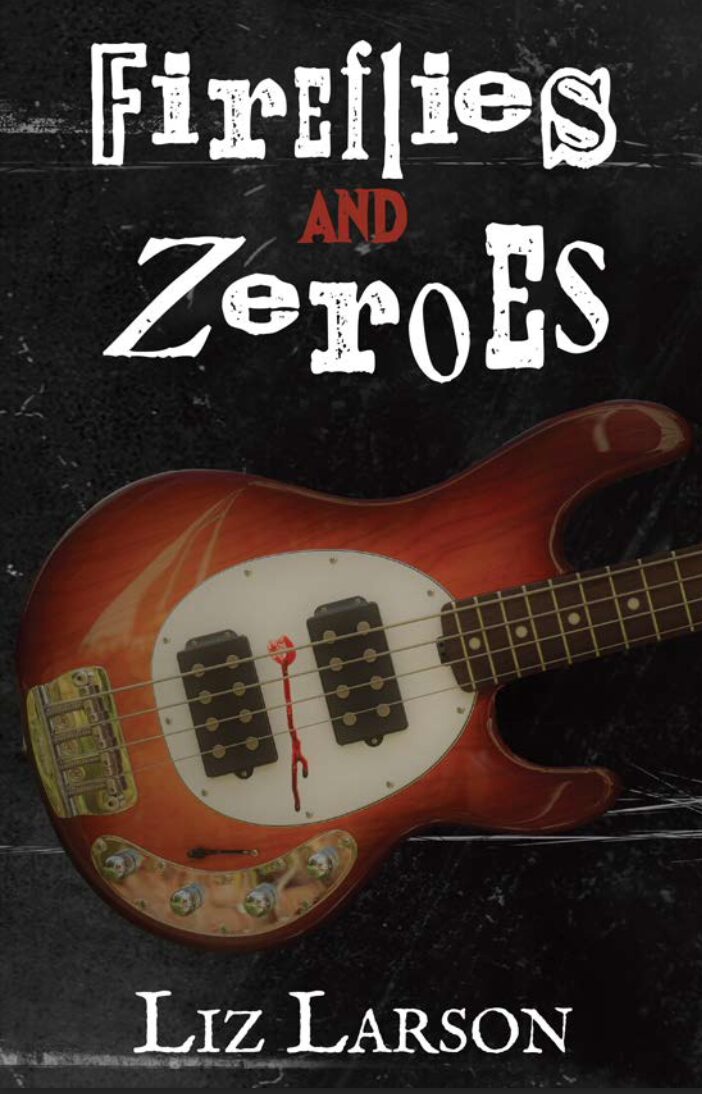Liz Larson’s “Fireflies and Zeroes” merges reality and fiction in thrilling intersectional mystery
5 min read
The cover of Liz Larson's debut novel, "Fireflies and Zeroes."
by NORAH WALSH
Editor-in-Chief
During the creation of her debut novel “Fireflies and Zeroes,” Liz Larson explained that her characters developed voices of their own, pushing back on her storyline and leading her into the mystery that lay ahead.
“I spend so much time just having arguments in my head with these characters,” she said. “They have full-fledged, strong personalities and take on a life of their own.”
The novel centers around the band members of The Generation—Tara, Max and Jason—who host an extravagant party to celebrate the end of their hiatus and the release of their first love song. But the festivities turn into chaos after a partygoer is murdered and Max—the lead singer—is kidnapped.
With their concert approaching, Tara and Jason—with the help of Max’s nearly identical younger brother, Alex—depend on coffee, nerves and their adoration of Max to fit the puzzle pieces together and solve the mystery of where their friend is, if he’s alive and why he was kidnapped.
Set in Charlottesville, Va., “Fireflies and Zeroes” references the nostalgic beauty of Virginia; a Virginia for lovers, filled with dancing fireflies and treasured honeysuckle that becomes sweeter in the sticky humidity.
But, as the preface highlights the date Aug. 12, 2017, sweet memories turn sour and images of the infamous Unite the Right rally lie in tandem with the fictional—yet distinctly familiar—feelings that Jason and Tara express in direct response to the news of white nationalists marching through the University of Virginia’s campus with torches and attacking counter-protesters.
Larson, originally from State College, Penn., discussed the closeness of complicated history in the South, reflecting on her experiences as an undergraduate—and now graduate—student at the University of Virginia.
“I’m inclined to say—especially in the South—there’s a lot of history that you barely have to scratch the surface to run into,” said Larson. “I grew up in Pennsylvania, and sitting in history class learning about the Civil War feels very different in a very white town in Pennsylvania than it does in Charlottesville.”
She continued, “And so this is the Charlottesville side of me that felt compelled to say ‘I need to tell this story.’ And there are personal elements to it, but also this is something we should be talking about. This is a series of events that were not just the headlines that everyone saw and were not just limited to Charlottesville.”
Larson carries the conversation of intersectionality and equality into her characters, specifically Tara, a young Black female drummer. To do so, Tara’s perspective on the Unite the Right rally and her starkly different experience of existing in Charlottesville as a Black woman bring in conversations that the white characters in the novel hadn’t seriously considered.
Meanwhile, Larson’s approach to gender within these conversations derives from her own experiences as a bassist. She spoke about her familiarity with the male-dominated music industry.
“These are very white and male-dominated spaces, so a lot of myself that I put into Tara … was—[while] I don’t have the same, necessarily, cultural racial background as her—I know what it’s like to be the only woman in the room,” said Larson
“It’s a voice that we do need to hear,” she continued.
And she’s right, for these are necessary discussions about race, gender and the disparity of privilege inherent in both. Likewise, by including multiple perspectives, Larson is better able to blur the lines between fiction and reality, reminding the reader of the preface that serves to introduce these themes.
This discussion extended into the editing process as well, as Larson defended certain characters and their roles to make them more than stereotypes.
“I think the only thing I really had to fight for was not letting Tara become anyone’s mother in the slightest; not letting her fall into being more mature than everyone around her,” she said.
In addition to these conversations that make the reader contemplate their own reality, Larson also includes flashback scenes to develop Max and Jason’s closeness. She balances these tender moments with thrilling moments of anticipation—uniting angst, desperation and nostalgia in Jason’s mind as he risks everything to find Max.
The ideas that came together in the novel were developed over many years, according to Larson.
“My brain works on the scale of books. I’m not a short story person, but I’ll start writing a book and then it’ll sort of languish on various laptops for years,” she said, mentioning that the first scraps that helped construct this novel date back about a decade. “But I didn’t really sit down and pick it back up again until 2020.”
She reflected on writing her debut novel during the COVID-19 pandemic and she realized how much she had come to appreciate her surroundings.
“I found all the places that I was missing that I wanted to go were my area around me,” she said. “I wasn’t wanting to go on vacation somewhere far away; it was all the Charlottesville area.”
This novel is a love letter to Charlottesville, and Larson reinforces this in her dedication that includes a quote from William Faulkner: “For Charlottesville, with love; ‘not for the virtues, but despite the faults.’”
As Larson is currently working on her second novel, she shared words of advice for potential novelists.
“You don’t have to write something that you think is important or good; you have to write something that won’t get out of your head,” said Larson. “You have to write the story that insists on being there in your brain, and it will find its importance. It will find its mission.”
“Fireflies and Zeroes” was published by Brandylane Publishers on July 19, 2023. If you would like a signed copy of the novel, please email weeklyringer.eic@gmail.com for further information.
In the Jan. 26 article about Liz Larson’s novel “Fireflies and Zeroes,” the character Tara was described as a bassist. In the novel, Tara is the band’s drummer. The article has been changed to reflect this correction.










